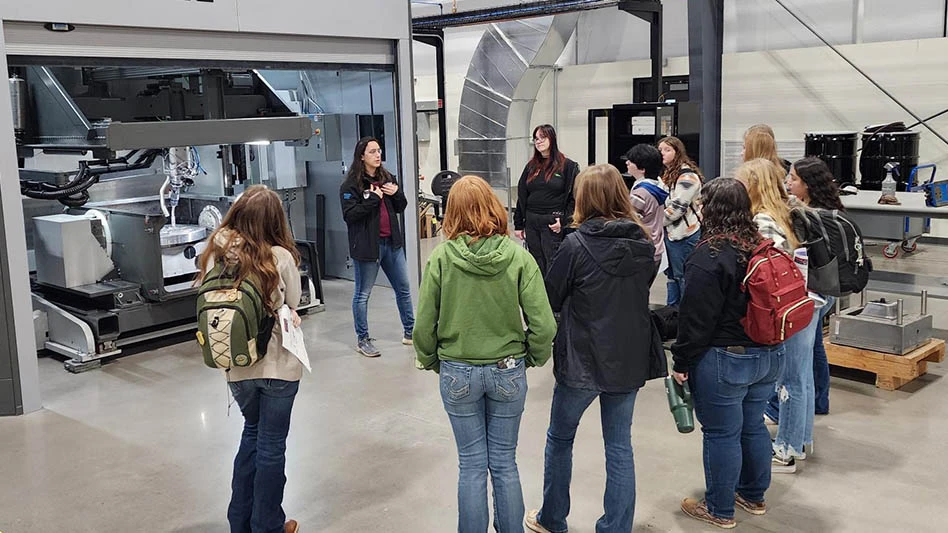
A group of U.K. engineers plans to build a mid-mass logistics drone capable of carrying a 100kg load. The system will be aimed initially at remote and isolated
The Sky Hopper unmanned aerial system (
The project’s commercial plan includes unmanned delivery networks that set up local communities as franchisees for aero-parks – locally owned assets through which multiple Sky Hopper missions are flown, creating revenue for local communities. www.skyhopper.co.uk
Honeywell, Intel launch UAV inspection service
To help industrial customers improve critical structure inspections while helping increase employee safety, the Honeywell InView inspection service will combine Intel’s Falcon 8+ unmanned aerial vehicle (UAV) system and Honeywell’s software customized for the utility, energy, infrastructure, and oil and gas industries. Honeywell provides certified pilots, the UAV, and sensors.
The InView inspection service package includes the UAV, pilot app, and customizable web portal to let customers organize and create standards around their routine and crisis-response inspections. Inspection data can be stored, searched, and accessed from the office or in the field.
Honeywell’s customized software can help customers log, analyze, and eventually predict or prevent outages and structural failures while protecting utility line workers.
By using the inspection service, utility companies can send a UAV to perform routine inspections of substations, transmission

Ohio State sets drone world speed record
The Ohio State University (OSU)’s Aerospace Research Center has set a world speed record for an unmanned aerial vehicle (UAV) of any size, pending verification. OSU’s UAV flew autonomously with sustained average speeds of 147mph over an out-and-back course approximately 28 miles over Lake Erie, which also set a record for the longest UAV flight over an out-and-back course. The Aug. 30,
The jet aircraft opens new capabilities for applications where both high speed and long range are critical.
The OSU 70 lb autonomous UAV, based on the Avanti radio-control airplane design, is a fixed-wing, single-engine turbojet carrying FAA registration N619RA. It is fitted with custom-built flight controller, long-range fuel tanks, redundant radio control links, control via satellite communications link, and ADS-B in/out transponder technology for avoiding collisions with other aircraft. Led by Engineering Professor Jim Gregory and Research Scientist Matt McCrink, the university’s team collaborated with Ligado for the satellite communications and with
The official record is pending review and certification by the National Aeronautic Association (NAA) and by the Fédération Aéronautique Internationale (FAI). An official observer representing the NAA was present for take-off and landing.
More than 40 OSU faculty are actively involved in research related to UAVs, spanning the domains of all-weather operations, flight testing, human factors, control link security, precision agriculture, regulatory policy, navigation system performance, vehicle control, and networked operations. OSU is a member of the FAA ASSURE Center of Excellence, with a research focus to enable safe and efficient integration of UAVs into the National Airspace System. https://engineering.osu.edu

MQ-1C Gray Eagle ER flies 41.9 hours
On Aug. 6, 2017, General Atomics Aeronautical Systems’ MQ-1C Gray Eagle Extended Range (MQ-1C ER) aircraft completed a 41.9-hour endurance flight, exceeding the 40-hour flight test goal. The standard Gray Eagle has an endurance of 25 hours.
The unmanned aircraft system (
The MQ-1C ER production aircraft will begin flight test in Dugway, Utah, to demonstrate mission capabilities including increased range, endurance, and payload capacity.
Further tests are to prepare for the U.S. Army fielding the aircraft in August 2018.
On Aug. 16, 2017, company pilots flew
“This flight is another milestone in our progression towards delivering an RPA system that meets North Atlantic Treaty Organization (NATO) airworthiness requirements for
Advanced Aircraft Co. introduces hybrid Hercules UAS
Advanced Aircraft Co. (AAC) is introducing its Hercules long endurance, multi-rotor unmanned aerial system (
Hercules is powered by an in-flight generator and auxiliary battery. The gas-fueled combustion engine provides long endurance and the battery provides reliability should the combustion engine fail. The battery contains enough energy to fly the aircraft for an additional 2 minutes following the failure of the combustion engine, enabling the aircraft to make a safe landing.
The aircraft supplies 50W at 28VDC to two payload bays. One in the nose is intended for a 1 lb to 2 lb camera turret, while the center-of-gravity payload bay can be used for additional payload or a second fuel tank for longer endurance.
AAC plans to begin customer deliveries of the Hercules unmanned aerial system (
University of Michigan complex for small UAS flight testing
A lab for testing autonomous unmanned aerial vehicles (
An enclosed, four-story complex, M-Air will be next to the Ford Motor Co. Robotics Building, set to open in 2019. M-Air’s 80ft x 120ft floor will be grass, and its walls black polyester netting held in place with structural steel poles. A pavilion will host up to 25 users, and adjustable lighting will make the center useable in the evening. Construction of the $800,000 M-Air is expected to be complete by the end of the year.
The robotics building will hold a three-story fly zone where

Explore the October 2017 Issue
Check out more from this issue and find your next story to read.
Latest from Aerospace Manufacturing and Design
- 2024 Favorites: #6 Article – Mastering complex precision machined parts
- 2024 Favorites: #6 News – Boeing to acquire Spirit AeroSystems in $8.3B deal
- Season's greetings
- 2024 Favorites: #7 Article – Deep drawing aerospace components
- 2024 Favorites: #7 News – GKN Aerospace completes sale of St. Louis facility to Boeing
- 2024 Favorites: #8 Article – Beyond uptime
- 2024 Favorites: #8 News – NASA, Lockheed Martin reveal X-59
- 2024 Favorites: #9 Article – 5 tips for upskilling your aerospace machinists





